Effects of Strong Ground Motion with Identical Response Spectra and Different Duration on Pile Support Mechanism and Seismic Resistance of Spherical Gas Holders on Soft Ground
Abstract
:1. Introduction
2. Analysis Conditions
2.1. Ground Modeling
2.2. Holder Modeling
3. Input Seismic Motion
4. Behavior of Coupled Holder–Pile–Ground System during Earthquake
4.1. Seismic Performance Evaluation of Gas Holder during Long-Term Strong Ground Motion
4.2. Settlement Suppression Mechanism by Pile (Pile Member Force Evaluation)
4.3. Effect of Duration on Pile Support
5. Conclusions
- With regard to the characteristics of the mechanical response of the target alternating ground, when the duration of the input seismic motions was different despite the response spectrum being identical, the long-duration seismic motion (seismic motion (A)) had larger ground vibrations relative to the bottom of the ground (horizontal displacement) (i.e., larger shear displacement) and greater disturbance in the ground relative to the short-duration seismic motion (seismic motion (B)). As a result, the ground settlement amount in the former was larger than that in the latter.
- The long-duration seismic motion (seismic motion (A)) exhibited a large settlement suppression effect due to the pile. This was because the axial force of the pile, as well as the positive pore water pressure, increased owing to the stress redistribution caused by the decrease in the effective confining pressure of the sand and clay layers during the earthquake, which increased the pile resistance (i.e., allowable bending moment). Consequently, when the pile damage gradually progressed with seismic motion (A), the pile could maintain support functions for a certain period of time, even if the pile was ultimately damaged in all sections.
- Furthermore, the short-duration seismic motion (seismic motion (B)) exhibited almost no settlement suppression effect due to the pile. In the case of seismic motion (B), an extremely high maximum acceleration acted on the ground in a very short period of time, and the piles were suddenly damaged in almost all sections. This was because the support function of the pile was lost almost instantaneously without the increased resistance of the pile, which was generated by the decreased ground rigidity, having had no time to appear, in contrast to the case of seismic motion (A).
- These results show that the ground response and pile failure modes can differ if the duration differs, even if the input ground motion has the same acceleration response spectrum. The results suggest that duration will need to be considered in the future when selecting seismic motions to be used in evaluations.
- In this study, we were able to verify the possibility of the collapse of the holder during strong L2 class ground motions, including those with long durations. As a result, we will take all possible safety measures to prevent the holders from malfunctioning even after a large-scale natural disaster occurs. In order to further improve this research, it is necessary to evaluate the effects of geological composition (such as different soil conditions, geological irregularities, and so on) and the input seismic motion (in the case of seismic response spectra containing more short-period components, and the influence of consecutive earthquakes). Therefore, we will increase the number of analysis cases to deal with these issues in the future.
Author Contributions
Funding
Institutional Review Board Statement
Informed Consent Statement
Data Availability Statement
Acknowledgments
Conflicts of Interest
Appendix A
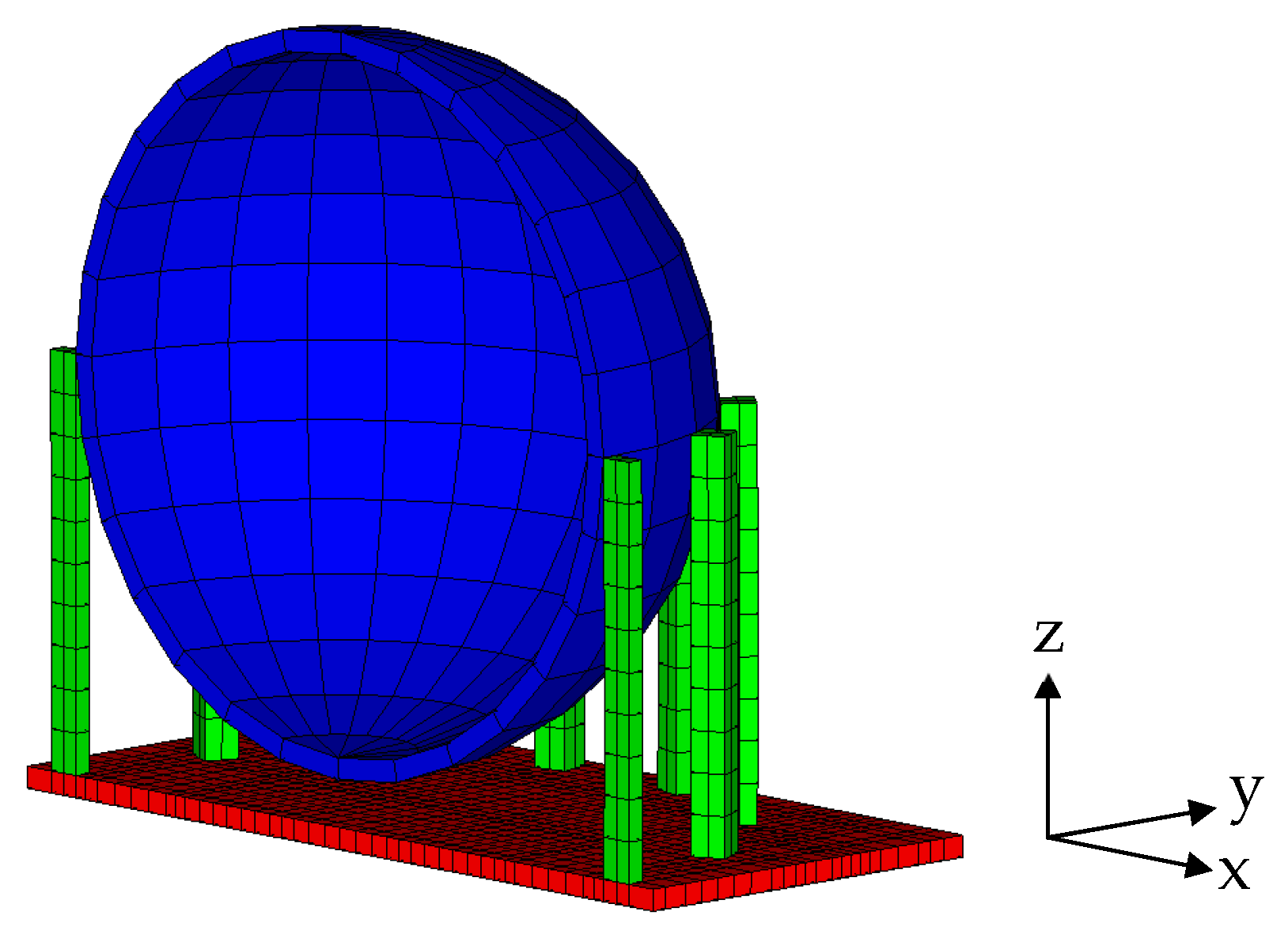

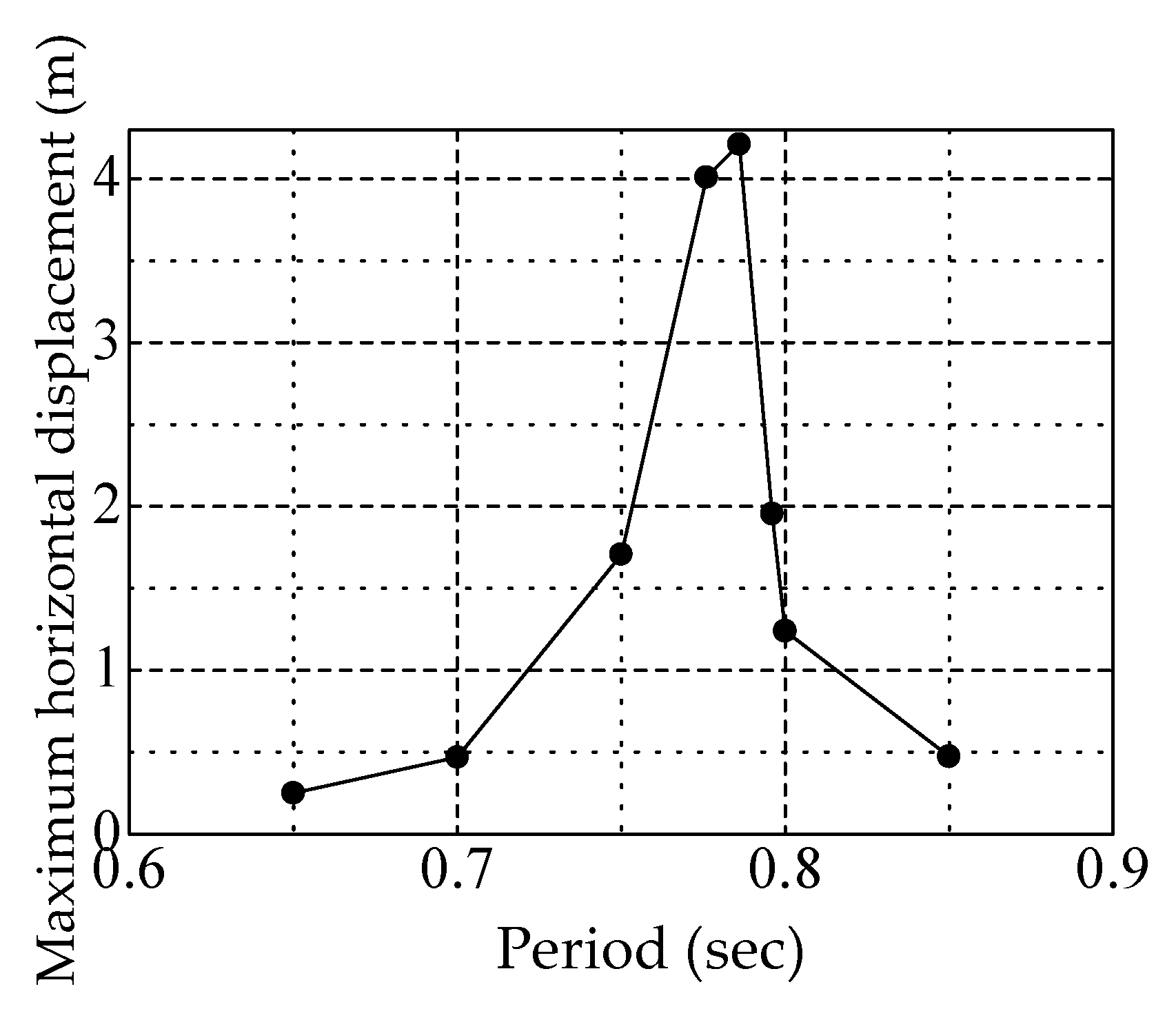
References
- Tokyo Metropolitan Government. Tokyo Metropolitan Land Resilience Regional Plan; Tokyo Metropolitan Government: Tokyo, Japan, 2016; p. 63. (In Japanese)
- Ministry of Land, Infrastructure, Transport and Tourism. White Paper on Land, Infrastructure, Transport and Tourism in Japan; Ministry of Land, Infrastructure, Transport and Tourism: Tokyo, Japan, 2021; pp. 23–24. (In Japanese) [Google Scholar]
- Boulanger, R.W.; Curras, C.J.; Kutter, B.L.; Wilson, D.W.; Abghari, A. Seismic soil-pile-structure interaction experiments and analyses. J. Geotech. Geoenviron. Eng. 1999, 125, 750–759. [Google Scholar] [CrossRef]
- Turner, B.J.; Brandenberg, S.J.; Stewart, J.P. Influence of Kinematic SSI on Foundation Input Motions for Bridges on Deep Foundations; PEER Report of Pacific Earthquake Engineering Research Center No.2017/08; University of California: Berkeley, CA, USA, 2017. [Google Scholar]
- Nogami, T.; Otani, J.; Konagai, K.; Chen, H.-L. Nonlinear soil-pile interaction model for dynamic lateral motion. J. Geotech. Eng. 1992, 118, 89–106. [Google Scholar] [CrossRef]
- Miyamoto, Y. Pile response during earthquake and performance evaluation of pile foundation. In Proceedings of the 2nd U.S.-Japan Workshop on Soil-Structure Interaction, Tsukuba, Japan, 6–8 March 2001. Paper No. B-6. [Google Scholar]
- Kimura, M.; Zhang, F. Seismic evaluations of pile foundations with three different methods based on three-dimensional elasto-plastic finite element analysis. Soils Found. 2000, 40, 113–132. [Google Scholar] [CrossRef] [Green Version]
- Kimura, Y.; Goto, T.; Matoba, M.; Tamura, S. Dynamic collapse mechanism and ultimate strength for circular tube pile based on centrifuge tests of superstructure-pile-liquefied soil system. J. Struct. Constr. Eng. 2016, 81, 2079–2089. (In Japanese) [Google Scholar] [CrossRef] [Green Version]
- Kaneko, O.; Nakai, S.; Mukai, T.; Hirade, T.; Iiba, M.; Abe, A. The flexural strength and deformation characteristics of precast concrete piles for estimation of seismic performance against severe earthquakes. AIJ J. Technol. Des. 2015, 21, 95–98. (In Japanese) [Google Scholar] [CrossRef] [Green Version]
- Tombari, A.; Dezi, F.; El Naggar, M.H. Soil-pile-structure interaction under seismic loads: Influence of ground motion intensity, duration and non-linearity. In Proceedings of the 15th World Conference on Earthquake Engineering, Lisbon, Portugal, 24–28 September 2012. Paper No.5271. [Google Scholar]
- Noda, T.; Asaoka, A.; Nakano, M. Soil-water coupled finite deformation analysis based on a rate-type equation of motion incorporating the SYS Cam-clay model. Soils Found. 2008, 48, 771–790. [Google Scholar] [CrossRef] [Green Version]
- Asaoka, A.; Noda, T.; Yamada, E.; Kaneda, K.; Nakano, M. An elasto-plastic description of two distinct volume change mechanisms of soils. Soils Found. 2002, 42, 47–57. [Google Scholar] [CrossRef] [Green Version]
- Kobayashi, M.; Noda, T.; Nakai, K.; Takaine, T.; Asaoka, A. D seismic response analysis of a spherical gas holder on a sandy ground considering a serious scenario by the greatest possible earthquake. J. Jpn. Soc. Civ. Eng. Ser. A2 Appl. Mech. AM 2018, 74, I_693–I_703. (In Japanese) [Google Scholar] [CrossRef]
- Kobayashi, M.; Takaine, T. Earthquake resistance evaluation of a spherical gas holder considering its ultimate state due to liquefaction-induced differential settlement of sandy ground. In Proceedings of the 16th Asian Regional Conference on Soil Mechanics and Geotechnical Engineering, Taipei, Taiwan, 14–18 October 2019. [Google Scholar]
- Japan Gas Association. Seismic Design Guidelines for Manufacturing Equipment; Japan Gas Association: Tokyo, Japan, 2014; pp. 156–157. (In Japanese) [Google Scholar]
- Izawa, J.; Ueda, K.; Murono, Y. Analytical study on soil liquefaction due to long duration earthquakes with low acceleration. J. Jpn. Soc. Civ. Eng. Ser. A1 Struct. Eng. Earthq. Eng. SE EE 2014, 70, I_513–I_519. (In Japanese) [Google Scholar] [CrossRef] [Green Version]
- Japanese Geotechnical Society. Report of the ground deformation research committee. In Proceedings of the JGS Special Symposium–Overcoming the Great East Japan Earthquake, Tokyo, Japan, 14–15 May 2014; pp. 9–20. (In Japanese). [Google Scholar]
- Tanaka, G.; Fujita, S.; Minagawa, K.; Aida, K. Development of vibration control for boiler structure of coal-fired power plant with earthquake having long period component and long duration. Trans. JSME 2019, 85, 18-00252. (In Japanese) [Google Scholar] [CrossRef]
- Zama, S. Liquid Sloshing of Oil Storage Tanks and Long-Period Strong Ground Motions in the 2003 Tokachi-Oki Earthquake. In Proceedings of the ASME/JSME 2004 Pressure Vessels and Piping Conference, Storage Tank Integrity and Materials Evaluation, San Diego, CA, USA, 25–29 July 2004; pp. 235–239. [Google Scholar] [CrossRef]
- Hatayama, K. Lessons from the 2003 Tokachi-oki, Japan, earthquake for prediction of long-period strong ground motions and sloshing damage to oil storage tanks. J. Seismol. 2008, 12, 255–263. [Google Scholar] [CrossRef]
- Li, Y.; Xi, X. Earthquake damage and countermeasure of industrial lifeline and equipment. In Earthquake Engineering Frontiers in the New Millennium, 1st ed.; Spencer, B.F., Hu, Y.X., Eds.; Routledge: London, UK, 2001; pp. 250–253. ISBN 90-2651-852-8. [Google Scholar]
- Noda, T.; Takeuchi, H.; Nakai, K.; Asaoka, A. Co-seismic and post-seismic behavior of an alternately layered sand-clay ground and embankment system accompanied by soil disturbance. Soils Found. 2009, 49, 739–756. [Google Scholar] [CrossRef] [Green Version]
- Noda, T.; Asaoka, A.; Yamada, S. Some bearing capacity characteristics of a structured naturally deposited clay soil. Soils Found. 2007, 47, 285–301. [Google Scholar] [CrossRef] [Green Version]
- Nakano, M.; Yamada, E.; Noda, T. Ground improvement of intermediate reclaimed land by compaction through cavity expansion of sand piles. Soils Found. 2008, 48, 653–671. [Google Scholar] [CrossRef] [Green Version]
- Schnabel, P.B.; Lysmer, J.; Seed, H.B. SHAKE—A Computer Program for Earthquake Response Analysis of Horizontally Layered Sites; Earthquake Engineering Research Center Report No. EERC 72-12; University of California: Berkeley, CA, USA, 1972. [Google Scholar]
- Asaoka, A.; Noda, T.; Fernando, G.S.K. Effects of changes in geometry on the linear elastic consolidation deformation. Soils Found. 1997, 37, 29–39. [Google Scholar] [CrossRef] [Green Version]
- Uzuoka, R.; Sento, N.; Yashima, A.; Zhang, F. 3-dimensional effective stress analysis of a damaged group-pile foundation adjacent to a quay wall. J. JAEE 2002, 2, 1–14. (In Japanese) [Google Scholar] [CrossRef] [Green Version]
- Toyo Asano Concrete Industry, Co., Ltd. Design Materials (PHC Pile/PC Pile); Toyo Asano Concrete Industry Co., Ltd.: Shizuoka, Japan, 1970. (In Japanese) [Google Scholar]
- Strong-Motion Earthquake Observation in Japanese Ports. Available online: http://www.mlit.go.jp/kowan/kyosin/eq.htm (accessed on 3 October 2021).
- Public Works Research Institute. Acceleration Strong-Motion Records in Civil Engineering Structures (No. 21); PWRI Report No. 64; Public Works Research Institute: Tsukuba, Japan, 1995. (In Japanese) [Google Scholar]
- Bolt, B.A. Duration of strong ground motion. In Proceedings of the 5th World Conference on Earthquake Engineering, Rome, Italy, 25–29 June 1973; pp. 1304–1313. [Google Scholar]
- Trifunac, M.D.; Brady, A.G. A study on the duration of strong earthquake ground motion. Bull. Seismol. Soc. Am. 1975, 65, 581–626. [Google Scholar]
- Kamiyama, M. A statistical analysis of duration and its related parameters with emphasis on soil conditions. J. Jpn. Soc. Civ. Eng. 1984, 1984, 271–280. (In Japanese) [Google Scholar] [CrossRef]
- Lysmer, J.; Kuhlemeyer, R.L. Finite dynamic model for infinite media. J. Eng. Mech. Div. 1969, 95, 859–877. [Google Scholar] [CrossRef]
- Joyner, W.B.; Chen, A.T.F. Calculation of nonlinear ground response in earthquakes. Bull. Seismol. Soc. Am. 1975, 65, 1315–1336. [Google Scholar] [CrossRef]
- Okada, T.; Oniki, K.; Kono, T.; Hoshikuma, J. Positive and negative alternating load test using pre-built RC pile foundation models. In Proceedings of the 18th Symposium on Seismic Design of Bridges based on Performance, Tokyo, Japan, 7–8 July 2015; pp. 27–34. (In Japanese). [Google Scholar]
- Hoshikuma, J. Research trends on the evaluation of seismic performance of existing bridges and seismic retrofitting. Found. Eng. Equip. 2016, 44–45, 7–11. (In Japanese) [Google Scholar]
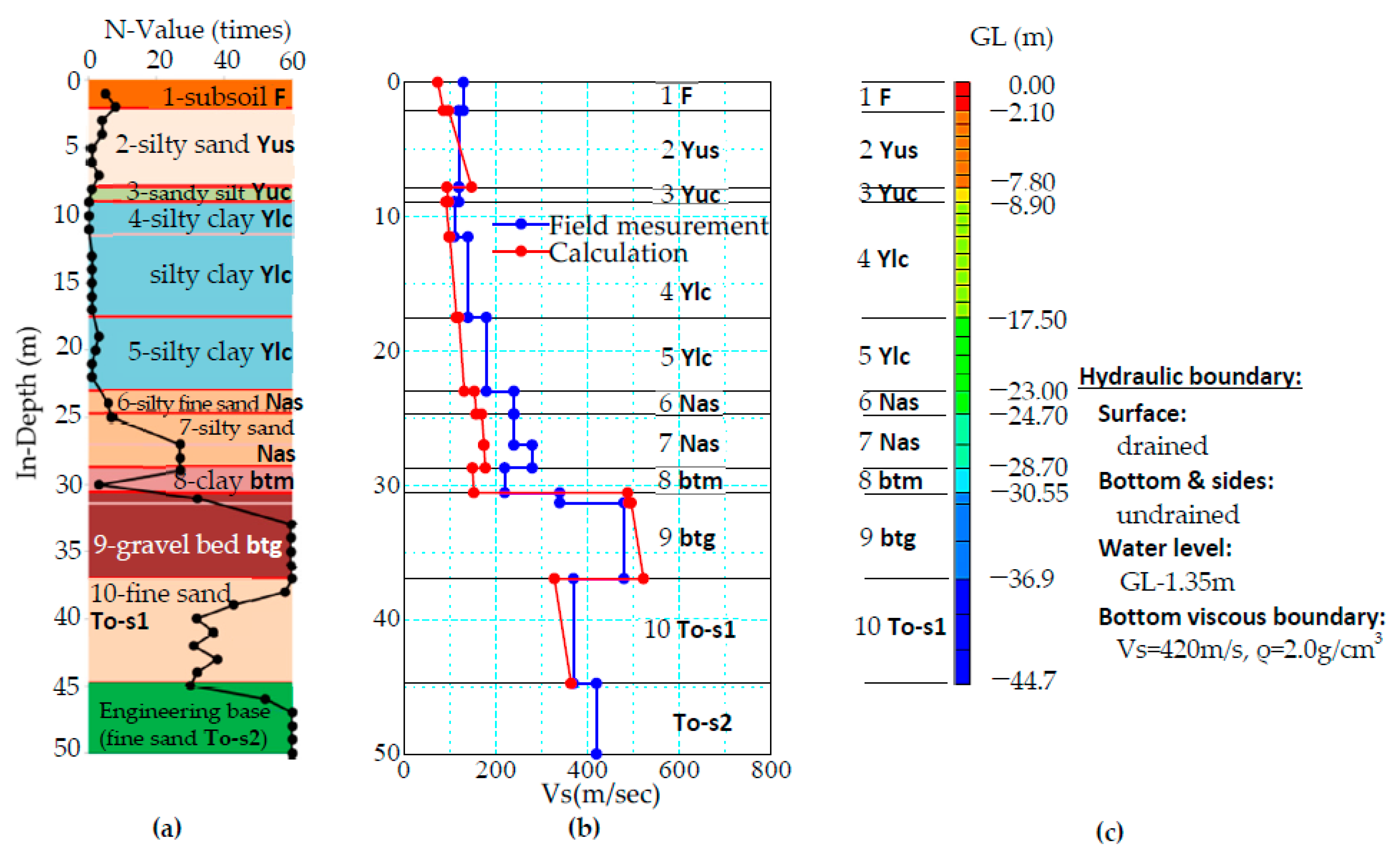

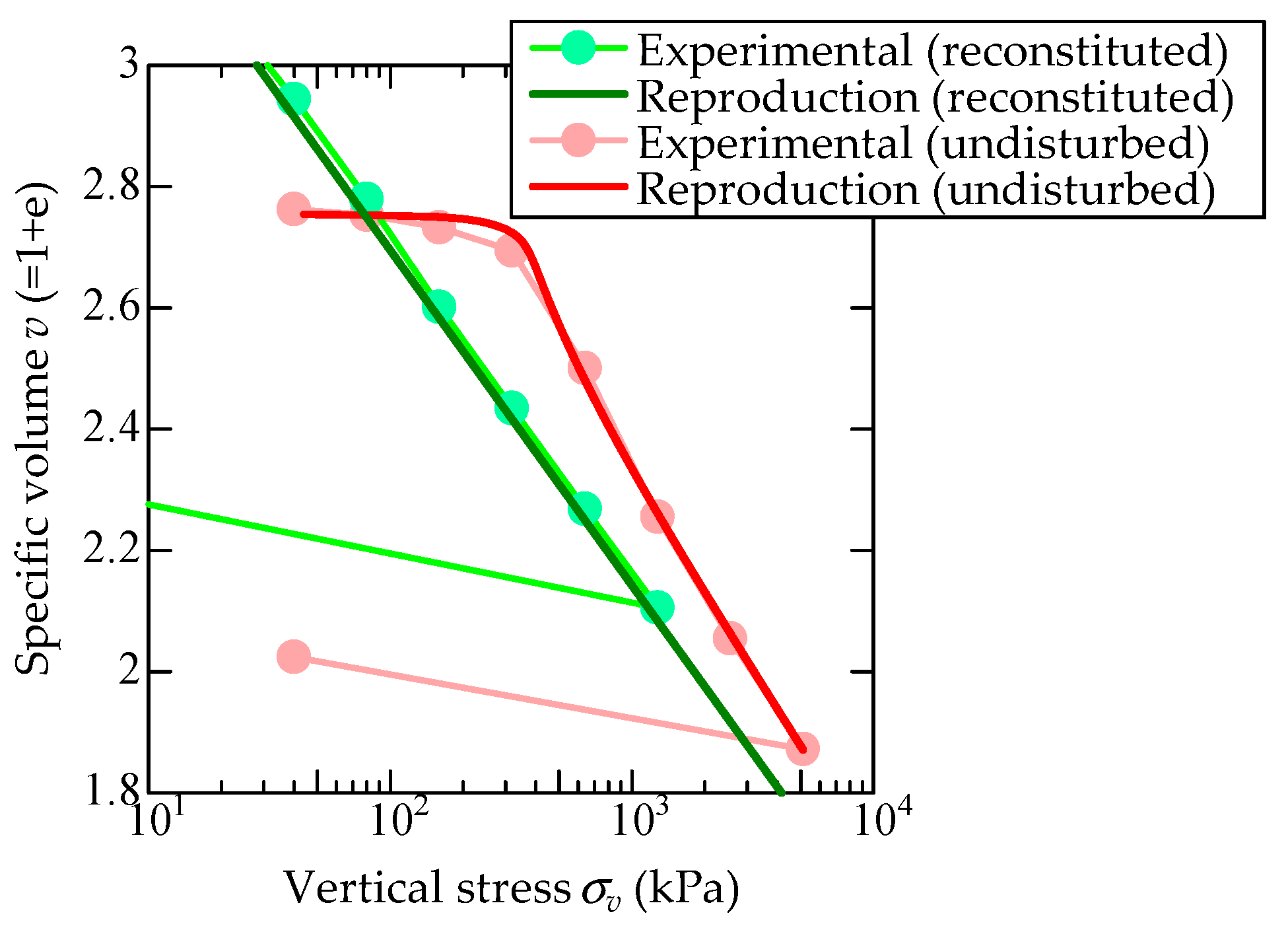
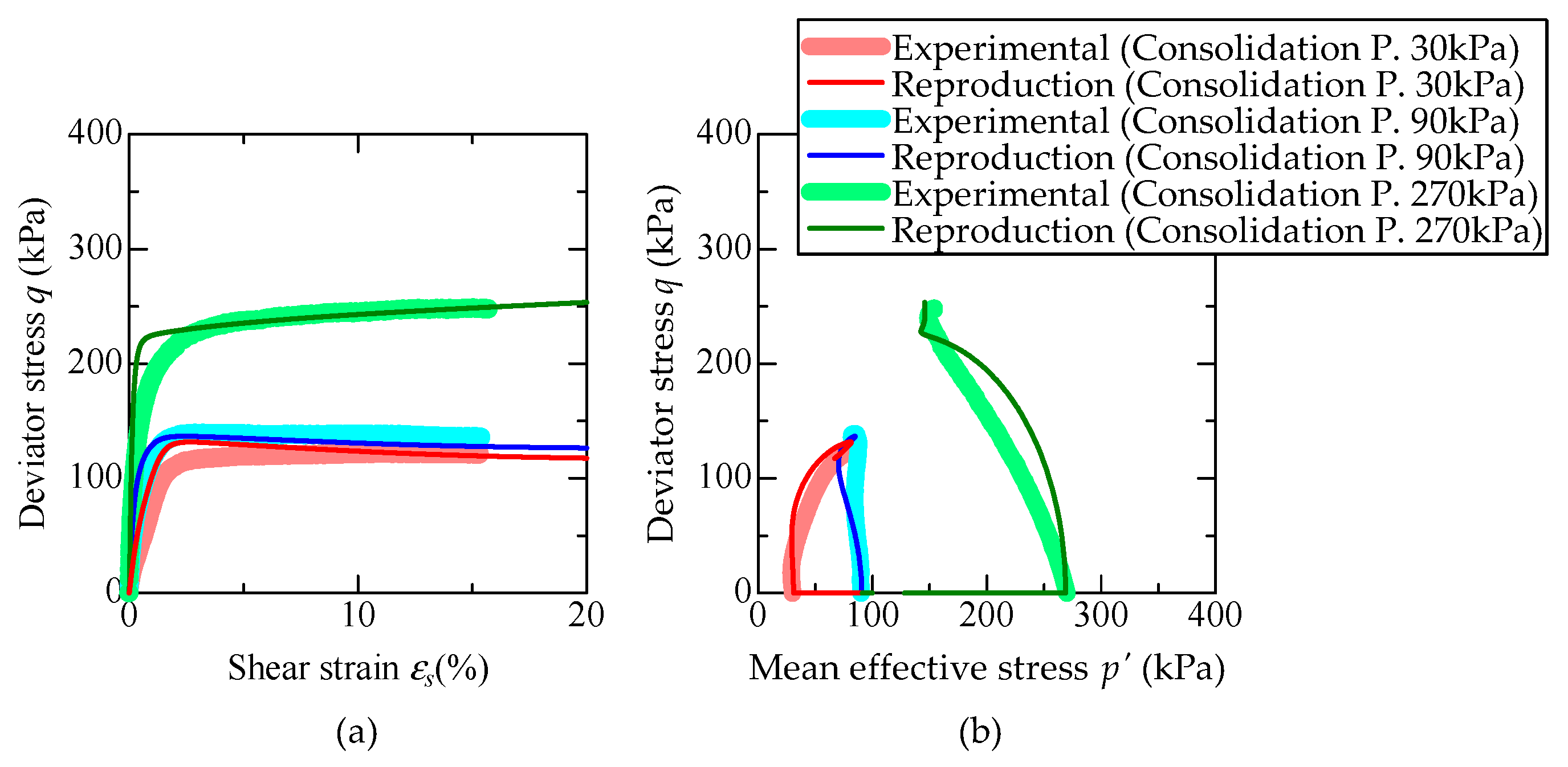
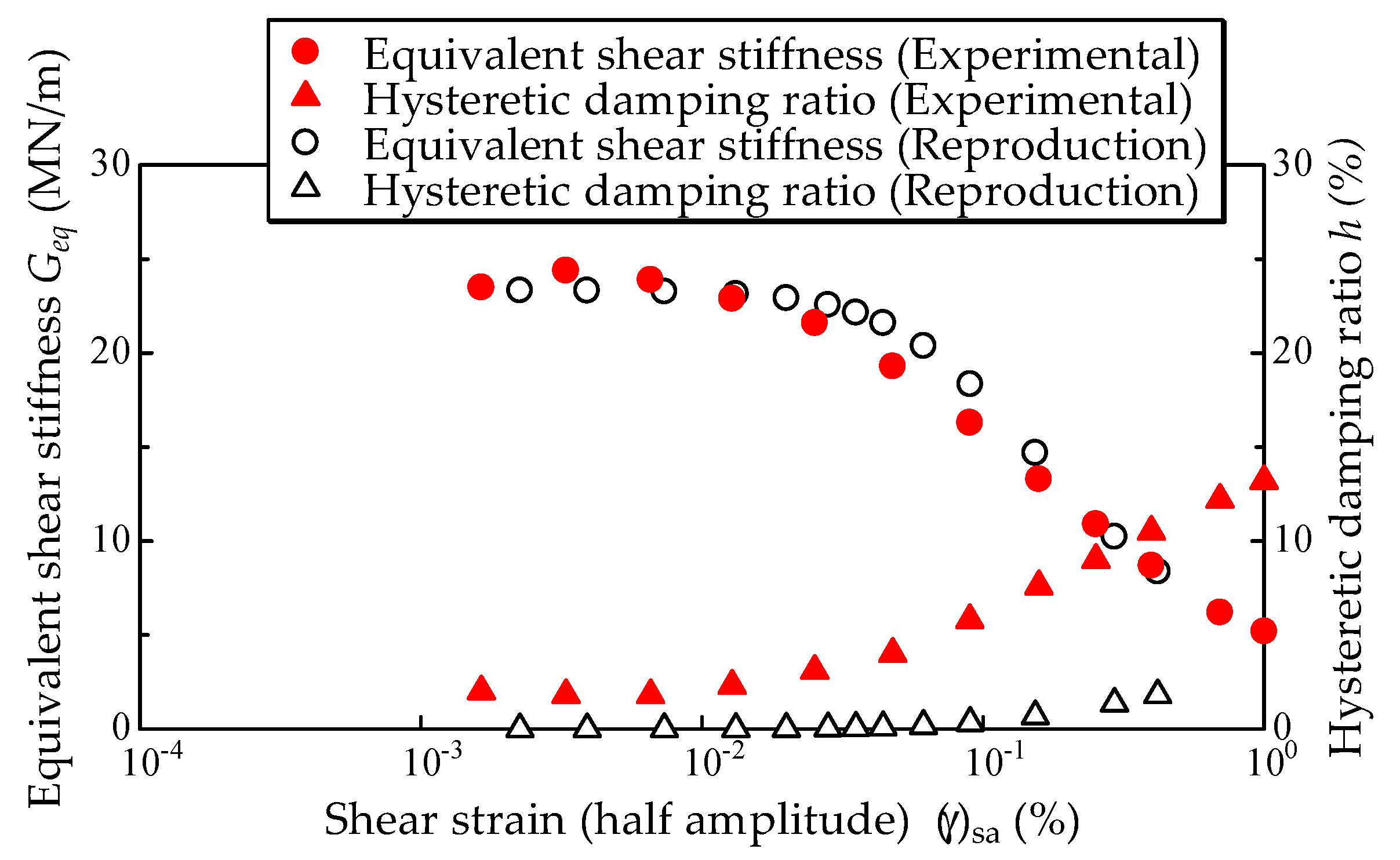


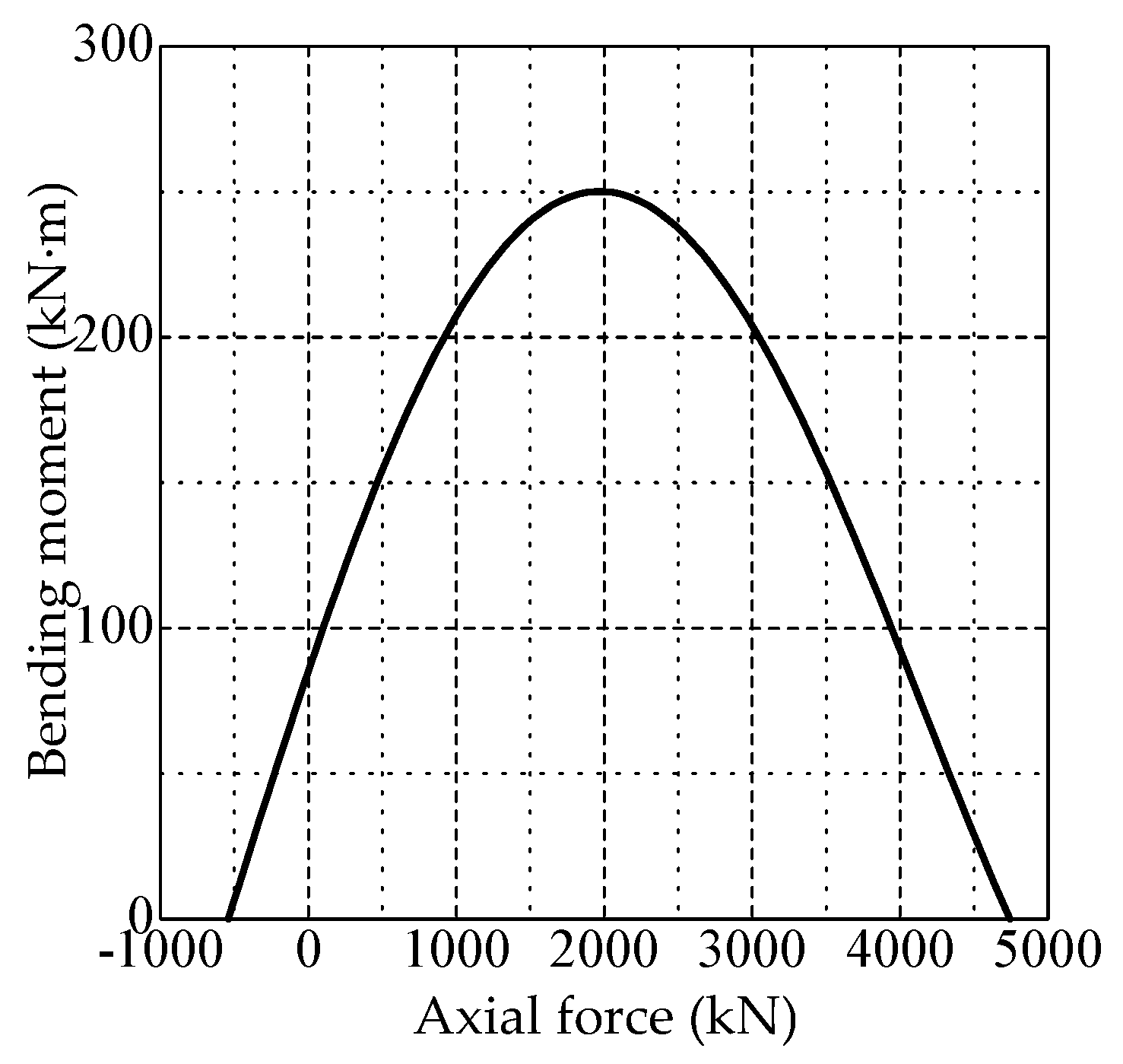
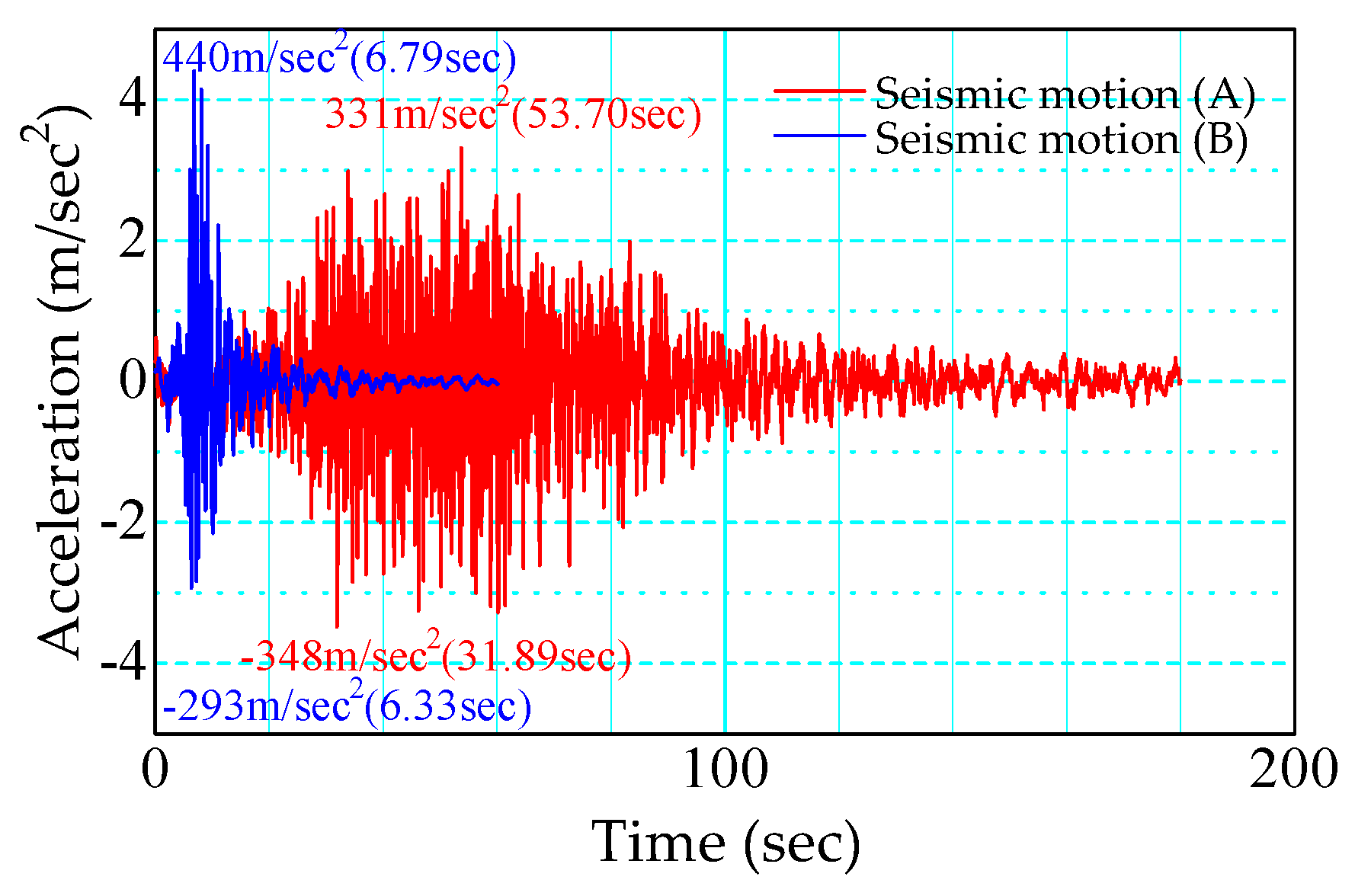


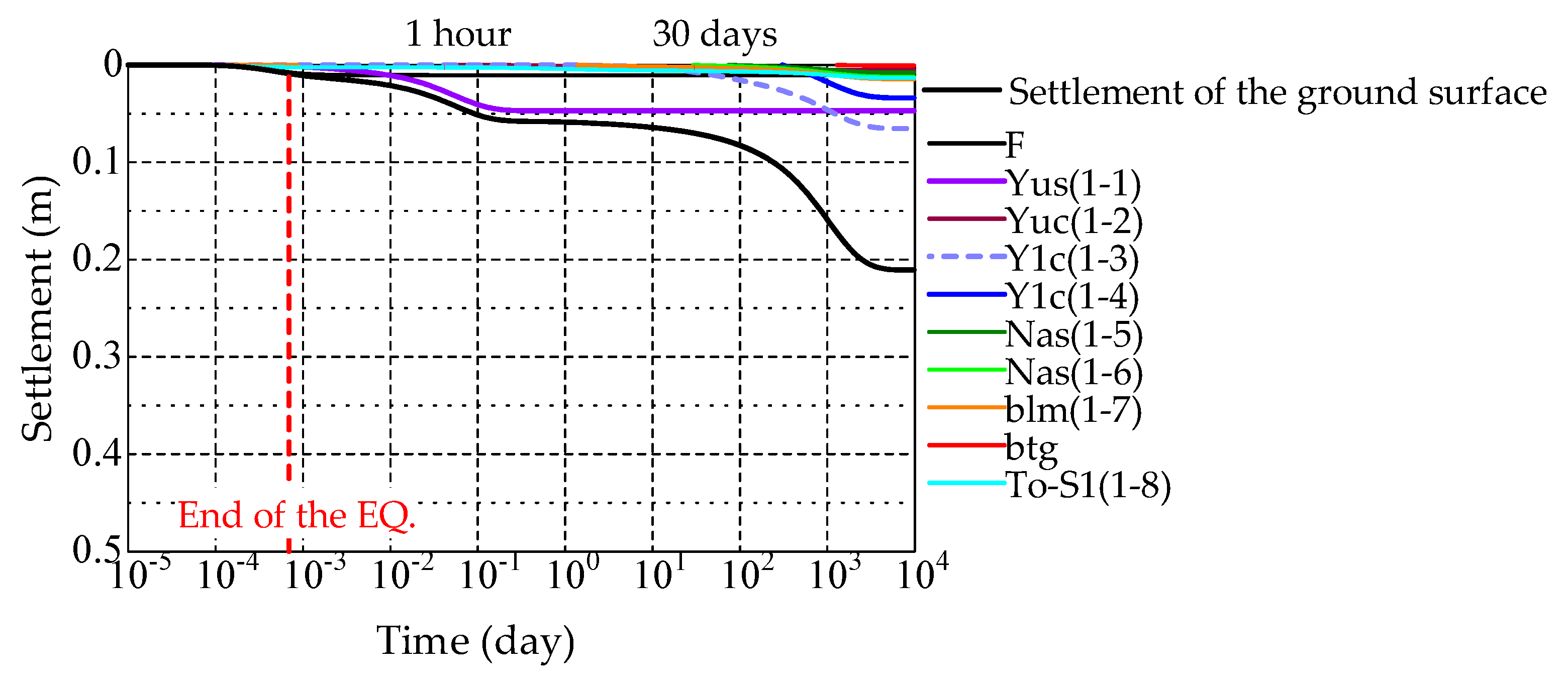
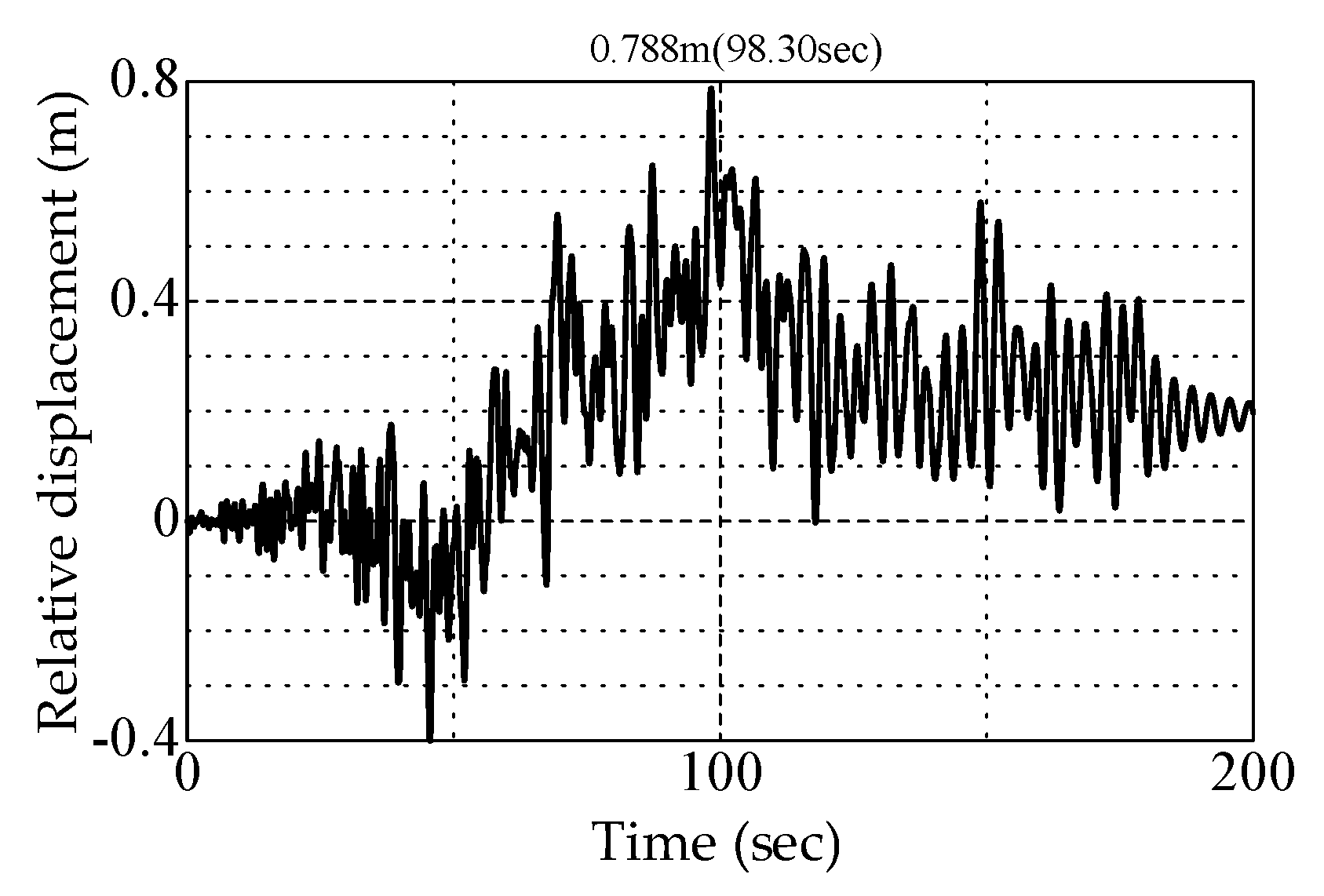
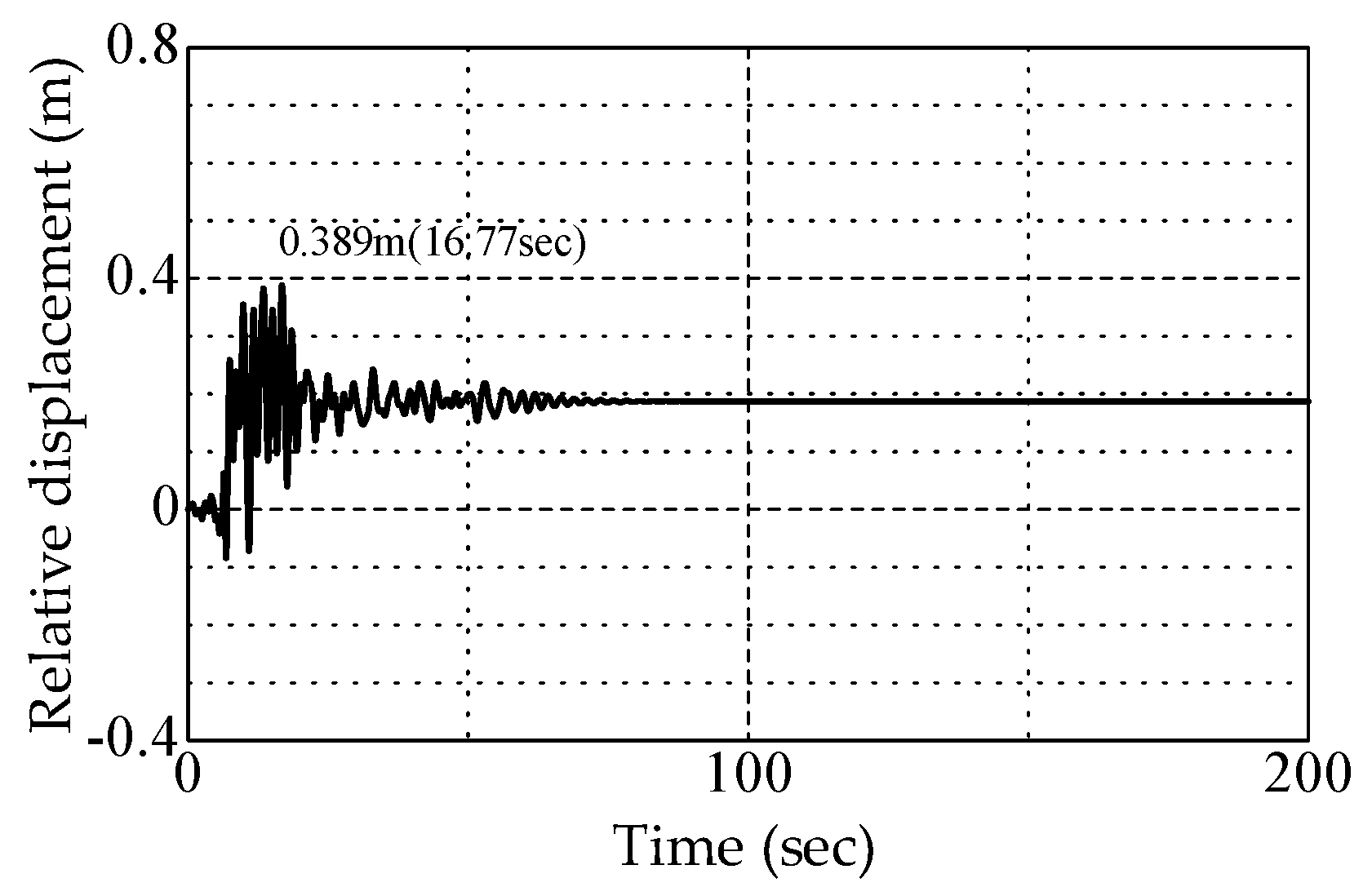
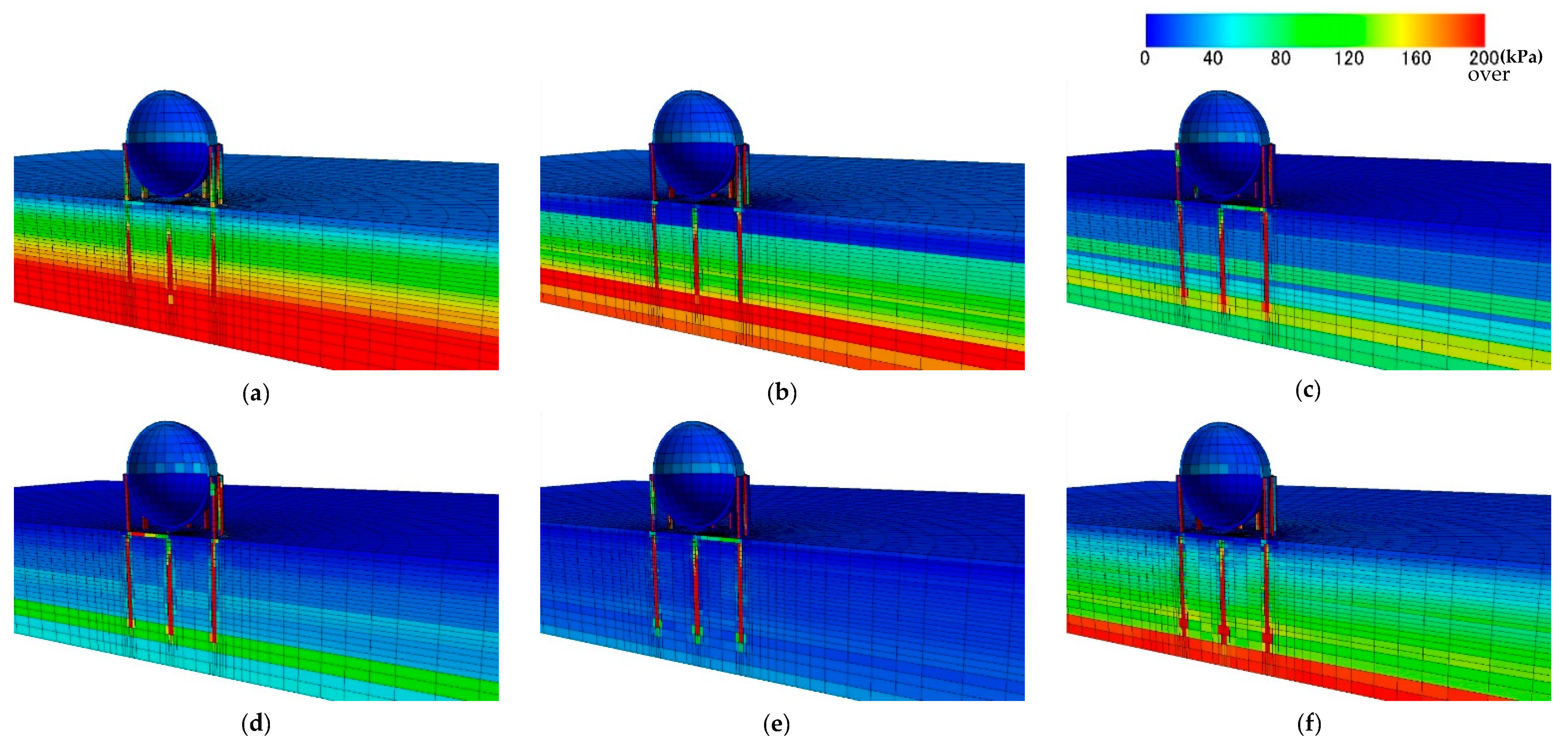
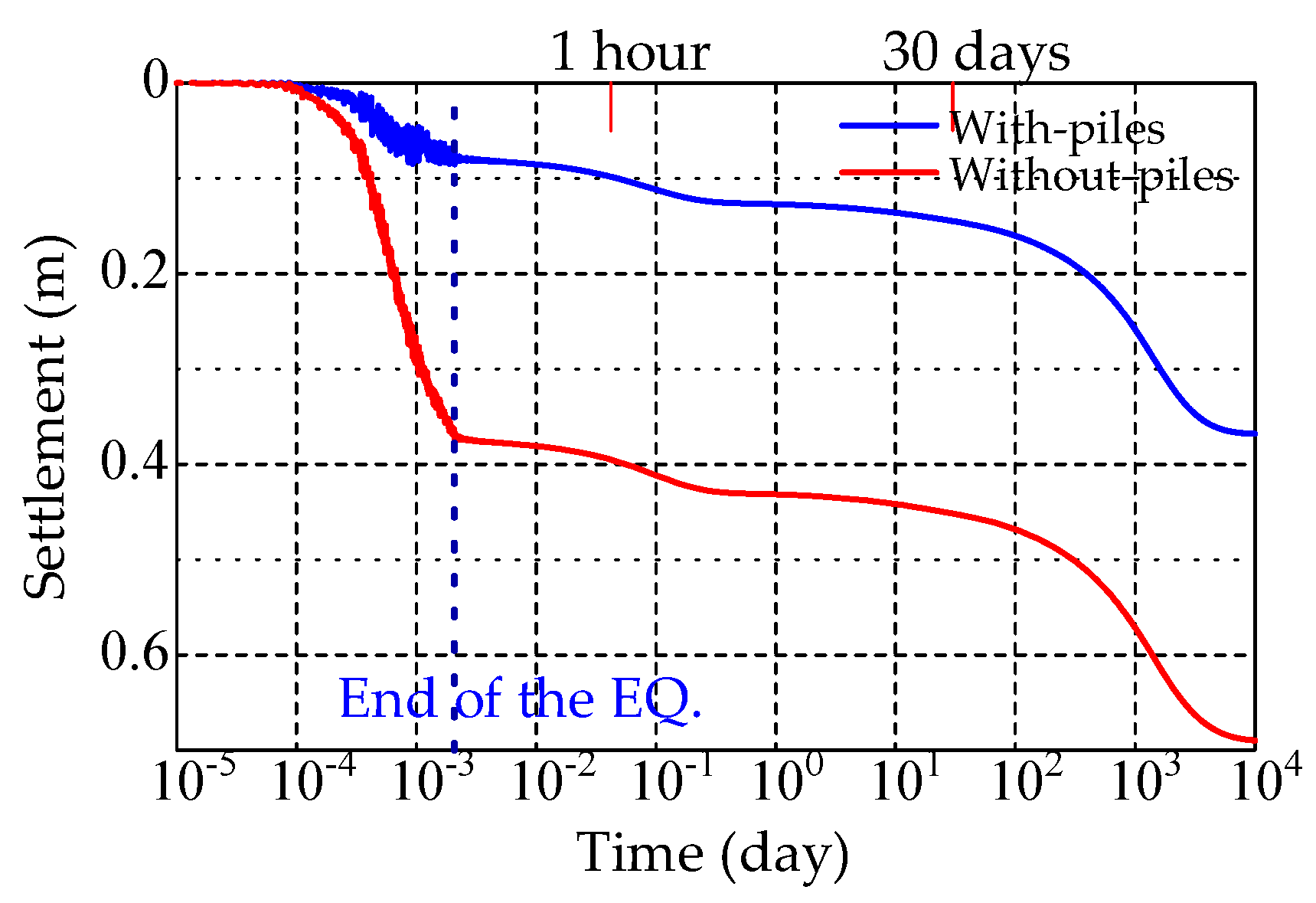

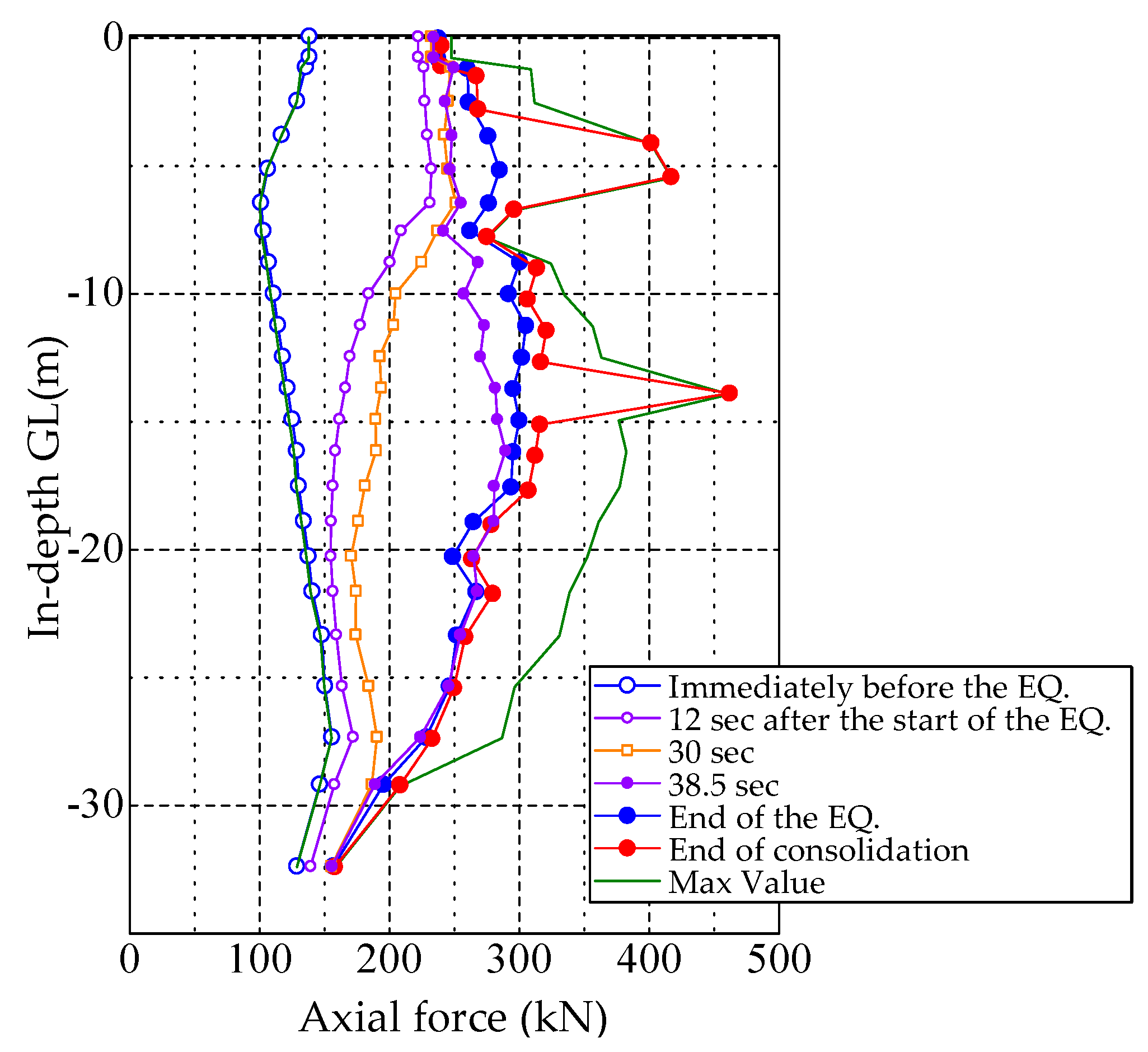


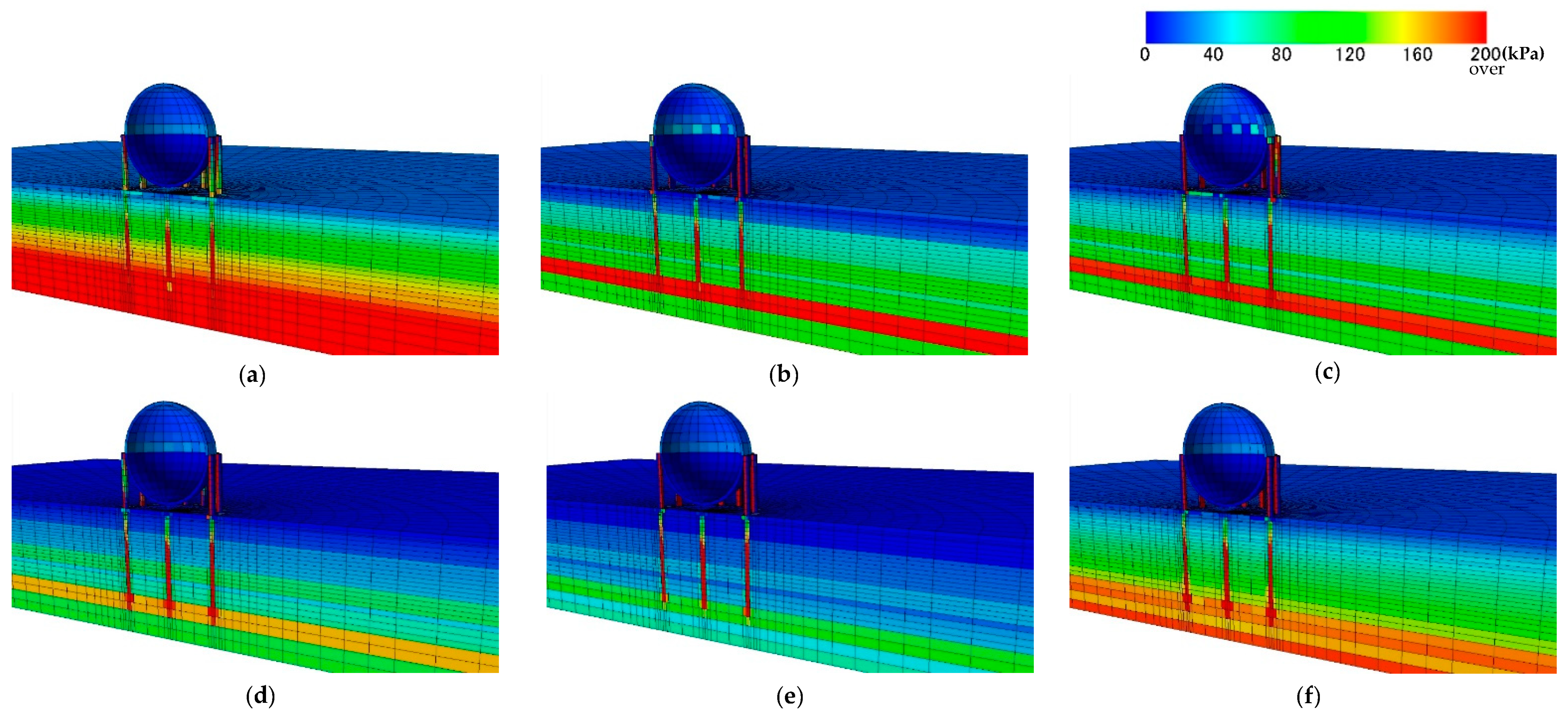


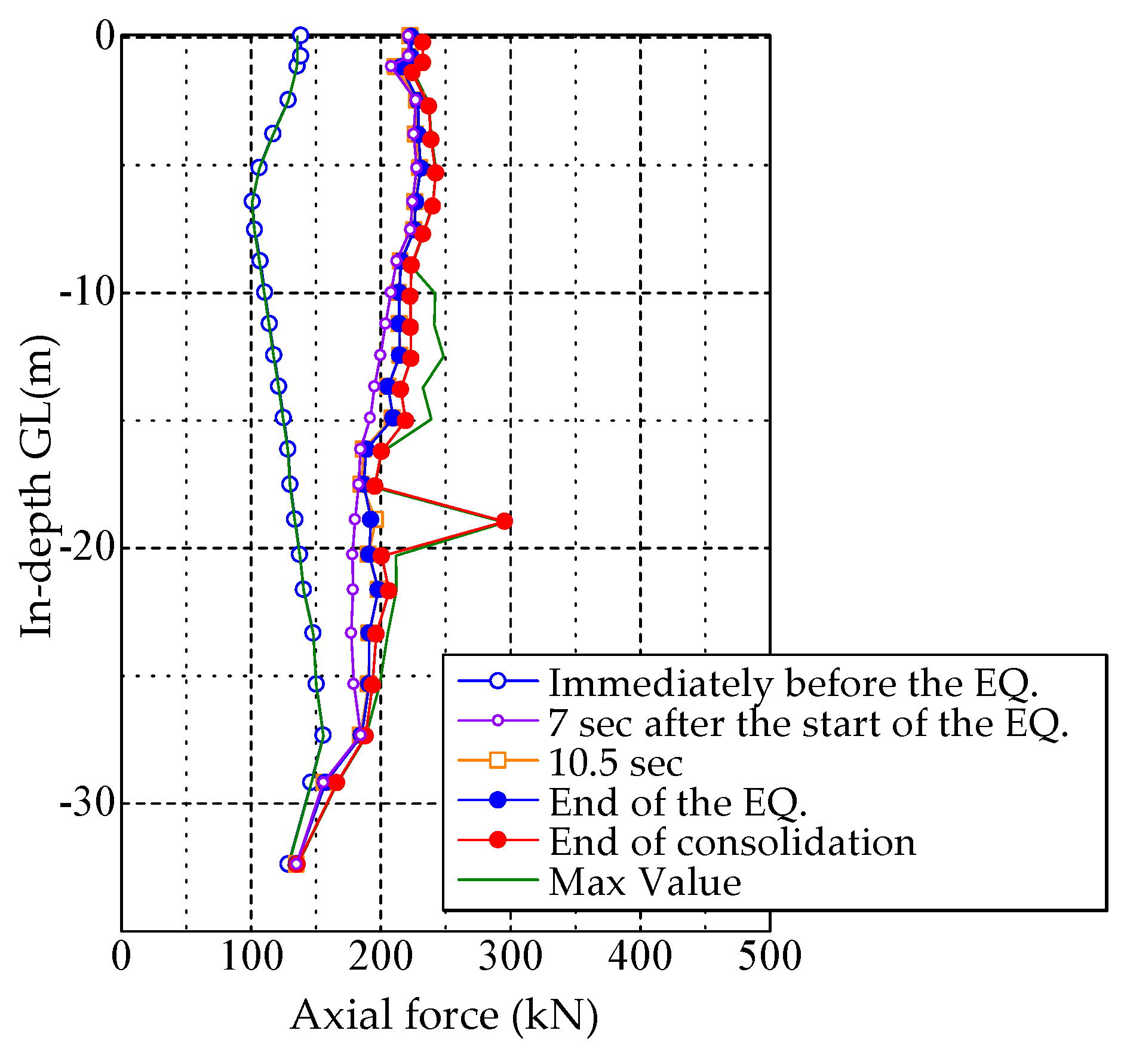
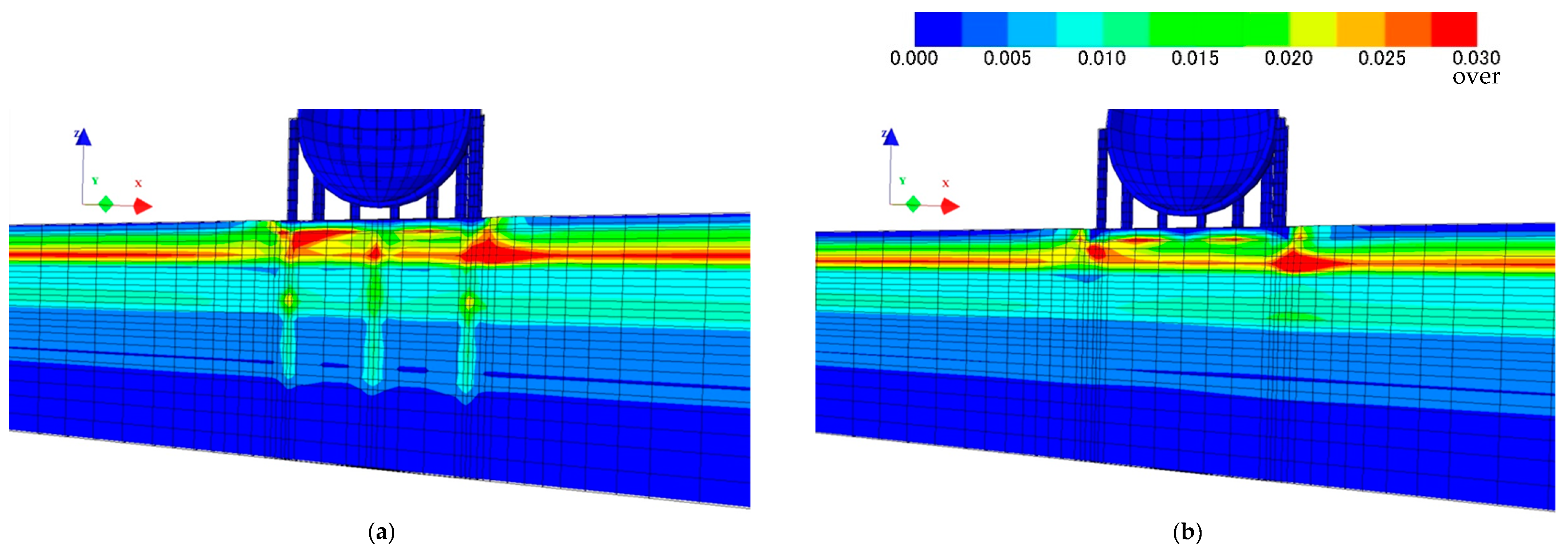
| Refilled Soil Layer F | Yurakucho Formation Yus | Yurakucho Formation Yuc(1-2) | Yurakucho Formation Ylc(1-3) | Yurakucho Formation Ylc(1-4) | Nanagochi Formation Nas(1-5) | Nanagochi Formation Nas(1-6) | Buried Terrace Formation blm(1-7) | Buried Terrace Formation btg | Tokyo Formation To-s1(1-8) | |
|---|---|---|---|---|---|---|---|---|---|---|
| In-depth G.L. (m) | −2.10 | −7.80 | −8.90 | −17.5 | −23.0 | −24.70 | −28.70 | −30.55 | −36.95 | −44.75 |
| Elasto-plastic parameters | ||||||||||
| Compression index | 0.125 | 0.050 | 0.170 | 0.280 | 0.280 | 0.065 | 0.065 | 0.092 | 0.05 | 0.057 |
| Swelling index | 0.005 | 0.003 | 0.012 | 0.019 | 0.018 | 0.0043 | 0.0038 | 0.0044 | 0.001 | 0.0017 |
| Critical state constant M | 1.30 | 1.60 | 1.60 | 1.40 | 1.70 | 1.43 | 1.43 | 1.40 | 1.20 | 1.45 |
| Specific volume at q = 0 and p’ = 98.1 (kN/m2) on NCL | 2.085 | 2.125 | 2.250 | 2.82 | 2.86 | 2.01 | 1.965 | 1.895 | 1.980 | 1.800 |
| Poisson’s ratio | 0.1 | 0.2 | 0.1 | 0.1 | 0.1 | 0.25 | 0.25 | 0.1 | 0.1 | 0.13 |
| Evolution rule parameters | ||||||||||
| Degradation index of overconsolidation m | 0.50 | 0.35 | 8.00 | 9.00 | 9.00 | 8.00 | 17.00 | 8.00 | 0.08 | 25.0 |
| Degradation index of structure a (b = c = 1) | 5.00 | 10.0 | 1.00 | 0.65 | 1.0 | 4.00 | 8.00 | 0.40 | 2.20 | 4.00 |
| Ratio of to | 1.00 | 0.80 | 0.80 | 0.40 | 0.70 | 1.00 | 1.00 | 1.00 | 1.00 | 1.00 |
| Evolution index of rotational hardening br | 3.50 | 0.10 | 0.20 | 0.20 | 0.20 | 3.00 | 3.00 | 0.10 | 3.50 | 3.00 |
| Limit of rotational hardening | 0.70 | 0.65 | 1.00 | 1.00 | 1.00 | 0.50 | 0.50 | 1.00 | 0.90 | 1.00 |
| Physical properties | ||||||||||
| Permeability k (cm/s) | 2.58 × 10−3 | 3.51 × 10−4 | 1.29 × 10−7 | 1.0 × 10−7 | 1.0 × 10−7 | 1.0 × 10−6 | 5.79 × 10−4 | 1.0 × 10−6 | 8.25 × 10−3 | 6.53 × 10−3 |
| Density of soil particles (g/cm3) | 2.030 | 2.735 | 2.765 | 2.625 | 2.626 | 2.684 | 2.747 | 2.672 | 2.000 | 2.663 |
| Initial conditions | ||||||||||
| Specific volume | 2.075 | 2.125 | 2.230 | 2.734 | 2.750 | 1.980 | 1.919 | 1.950 | 1.620 | 1.780 |
| Degree of structure | 1.60 | 1.10 | 1.60 | 1.40 | 1.90 | 1.20 | 1.10 | 5.20 | 1.00 | 3.00 |
| Overconsolidation ratio 1/R0 | 1.00 | 1.00 | 1.00 | 1.00 | 1.00 | 0.90 | 0.90 | 0.90 | 0.90 | 0.60 |
| Degree of anisotropy ζ0 | 1.00 | 1.00 | 1.00 | 1.00 | 1.00 | 0.90 | 0.90 | 0.90 | 0.90 | 0.60 |
| Items | Value |
|---|---|
| Nominal capacity | 200,000 m3 |
| Design pressure | 0.83 MPa |
| Inner diameter of the spherical shell | 35.560 m |
| Inner diameter of the foundation | 35.330 m |
| Holder equatorial height | 19.000 m |
| Thickness of the spherical shell plate | 35.0 mm |
| Outer diameter, thickness, and number of column | φ600 mm × 8 mm × 14 pcs. |
| Material of the spherical shell and columns | High tensile steel (JIS G3128; WEL-TEN870C) |
| Outer diameter of the braces | φ90 mm |
| Material of the braces | High strength steel (HBS G3102; HT690) |
| Unit Volume Weight (kN/m3) | Elastic Modulus (kN/m3) | Poisson’s Ratio | |
|---|---|---|---|
| Footing, Core | 25.00 | 2.35 × 107 | 0.2 |
| Radial beam | 18.86 | 1.07 × 106 | 0.2 |
| Underground beam | 22.66 | 1.85 × 107 | 0.2 |
| Perimeter reinforcement beam | 15.09 | 0.77 × 107 | 0.2 |
| Column | 0.448 | 1.70 × 107 | 0.3 |
| Spherical shell | 3.953 | 2.10 × 108 | 0.3 |
| Pile under the column | 2.935 | 3.19 × 105 | 0.2 |
| Pile under the core | 2.390 | 2.22 × 105 | 0.2 |
| Maximum Acc. (gal) | b-Duration tb (s) | p-Duration tp (s) | |
|---|---|---|---|
| Start-End Time of tb (s) | Start-End Time of tp(s) | ||
| Seismic motion (A) | 348 (217) | 171.4 (72.8) | 78.4 (45.2) |
| 0.0–171.4 (16.2–89.0) | 25.9–104.3 (31.0–76.2) | ||
| Seismic motion (B) | 440 (443) | 19.5 (13.3) | 11.7 (8.4) |
| 2.1–21.6 (5.3–18.7) | 5.3–17.0 (6.1–14.5) |
Publisher’s Note: MDPI stays neutral with regard to jurisdictional claims in published maps and institutional affiliations. |
© 2021 by the authors. Licensee MDPI, Basel, Switzerland. This article is an open access article distributed under the terms and conditions of the Creative Commons Attribution (CC BY) license (https://creativecommons.org/licenses/by/4.0/).
Share and Cite
Kobayashi, M.; Noda, T.; Nakai, K.; Takaine, T.; Asaoka, A. Effects of Strong Ground Motion with Identical Response Spectra and Different Duration on Pile Support Mechanism and Seismic Resistance of Spherical Gas Holders on Soft Ground. Appl. Sci. 2021, 11, 11152. https://doi.org/10.3390/app112311152
Kobayashi M, Noda T, Nakai K, Takaine T, Asaoka A. Effects of Strong Ground Motion with Identical Response Spectra and Different Duration on Pile Support Mechanism and Seismic Resistance of Spherical Gas Holders on Soft Ground. Applied Sciences. 2021; 11(23):11152. https://doi.org/10.3390/app112311152
Chicago/Turabian StyleKobayashi, Mio, Toshihiro Noda, Kentaro Nakai, Toshihiro Takaine, and Akira Asaoka. 2021. "Effects of Strong Ground Motion with Identical Response Spectra and Different Duration on Pile Support Mechanism and Seismic Resistance of Spherical Gas Holders on Soft Ground" Applied Sciences 11, no. 23: 11152. https://doi.org/10.3390/app112311152
APA StyleKobayashi, M., Noda, T., Nakai, K., Takaine, T., & Asaoka, A. (2021). Effects of Strong Ground Motion with Identical Response Spectra and Different Duration on Pile Support Mechanism and Seismic Resistance of Spherical Gas Holders on Soft Ground. Applied Sciences, 11(23), 11152. https://doi.org/10.3390/app112311152






